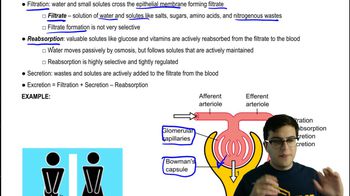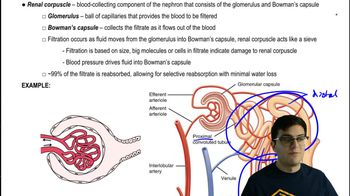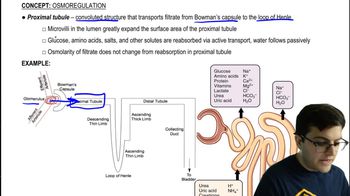Table of contents
- 1. Introduction to Biology2h 40m
- 2. Chemistry3h 40m
- 3. Water1h 26m
- 4. Biomolecules2h 23m
- 5. Cell Components2h 26m
- 6. The Membrane2h 31m
- 7. Energy and Metabolism2h 0m
- 8. Respiration2h 40m
- 9. Photosynthesis2h 49m
- 10. Cell Signaling59m
- 11. Cell Division2h 47m
- 12. Meiosis2h 0m
- 13. Mendelian Genetics4h 41m
- Introduction to Mendel's Experiments7m
- Genotype vs. Phenotype17m
- Punnett Squares13m
- Mendel's Experiments26m
- Mendel's Laws18m
- Monohybrid Crosses16m
- Test Crosses14m
- Dihybrid Crosses20m
- Punnett Square Probability26m
- Incomplete Dominance vs. Codominance20m
- Epistasis7m
- Non-Mendelian Genetics12m
- Pedigrees6m
- Autosomal Inheritance21m
- Sex-Linked Inheritance43m
- X-Inactivation9m
- 14. DNA Synthesis2h 27m
- 15. Gene Expression3h 20m
- 16. Regulation of Expression3h 31m
- Introduction to Regulation of Gene Expression13m
- Prokaryotic Gene Regulation via Operons27m
- The Lac Operon21m
- Glucose's Impact on Lac Operon25m
- The Trp Operon20m
- Review of the Lac Operon & Trp Operon11m
- Introduction to Eukaryotic Gene Regulation9m
- Eukaryotic Chromatin Modifications16m
- Eukaryotic Transcriptional Control22m
- Eukaryotic Post-Transcriptional Regulation28m
- Eukaryotic Post-Translational Regulation13m
- 17. Viruses37m
- 18. Biotechnology2h 58m
- 19. Genomics17m
- 20. Development1h 5m
- 21. Evolution3h 1m
- 22. Evolution of Populations3h 52m
- 23. Speciation1h 37m
- 24. History of Life on Earth2h 6m
- 25. Phylogeny2h 31m
- 26. Prokaryotes4h 59m
- 27. Protists1h 12m
- 28. Plants1h 22m
- 29. Fungi36m
- 30. Overview of Animals34m
- 31. Invertebrates1h 2m
- 32. Vertebrates50m
- 33. Plant Anatomy1h 3m
- 34. Vascular Plant Transport2m
- 35. Soil37m
- 36. Plant Reproduction47m
- 37. Plant Sensation and Response1h 9m
- 38. Animal Form and Function1h 19m
- 39. Digestive System10m
- 40. Circulatory System1h 57m
- 41. Immune System1h 12m
- 42. Osmoregulation and Excretion50m
- 43. Endocrine System4m
- 44. Animal Reproduction2m
- 45. Nervous System55m
- 46. Sensory Systems46m
- 47. Muscle Systems23m
- 48. Ecology3h 11m
- Introduction to Ecology20m
- Biogeography14m
- Earth's Climate Patterns50m
- Introduction to Terrestrial Biomes10m
- Terrestrial Biomes: Near Equator13m
- Terrestrial Biomes: Temperate Regions10m
- Terrestrial Biomes: Northern Regions15m
- Introduction to Aquatic Biomes27m
- Freshwater Aquatic Biomes14m
- Marine Aquatic Biomes13m
- 49. Animal Behavior28m
- 50. Population Ecology3h 41m
- Introduction to Population Ecology28m
- Population Sampling Methods23m
- Life History12m
- Population Demography17m
- Factors Limiting Population Growth14m
- Introduction to Population Growth Models22m
- Linear Population Growth6m
- Exponential Population Growth29m
- Logistic Population Growth32m
- r/K Selection10m
- The Human Population22m
- 51. Community Ecology2h 46m
- Introduction to Community Ecology2m
- Introduction to Community Interactions9m
- Community Interactions: Competition (-/-)38m
- Community Interactions: Exploitation (+/-)23m
- Community Interactions: Mutualism (+/+) & Commensalism (+/0)9m
- Community Structure35m
- Community Dynamics26m
- Geographic Impact on Communities21m
- 52. Ecosystems2h 36m
- 53. Conservation Biology24m
42. Osmoregulation and Excretion
Osmoregulation and Excretion
Problem 9
Textbook Question
Textbook QuestionBiologists have been able to produce mice that lack functioning genes for aquaporins. How would the urine of these mice compare to that of mice with normal aquaporins? a. lower volume and lower osmolarity b. lower volume and higher osmolarity c. higher volume and lower osmolarity d. higher volume and higher osmolarity
 Verified step by step guidance
Verified step by step guidance1
Step 1: Understand the role of aquaporins. Aquaporins are proteins that form pores in the cell membrane, allowing water to move in and out of the cell. They play a crucial role in the kidney's ability to concentrate urine.
Step 2: Consider the effect of lacking aquaporins. If the mice lack functioning genes for aquaporins, their cells would be less permeable to water. This means that less water would be reabsorbed from the urine in the kidneys.
Step 3: Predict the effect on urine volume. If less water is reabsorbed, the volume of urine would be higher.
Step 4: Predict the effect on urine osmolarity. If less water is reabsorbed, the urine would be less concentrated, meaning it would have a lower osmolarity.
Step 5: Match your predictions to the answer choices. The urine of mice lacking functioning genes for aquaporins would have a higher volume and lower osmolarity, so the correct answer is (c).
Recommended similar problem, with video answer:
 Verified Solution
Verified SolutionThis video solution was recommended by our tutors as helpful for the problem above
Video duration:
2mPlay a video:
Was this helpful?
Key Concepts
Here are the essential concepts you must grasp in order to answer the question correctly.
Aquaporins
Aquaporins are specialized membrane proteins that facilitate the transport of water across cell membranes. They play a crucial role in regulating water balance in various tissues, particularly in the kidneys, where they help concentrate urine by allowing water reabsorption. Mice lacking functional aquaporins would struggle to retain water, leading to significant changes in urine composition.
Recommended video:
Guided course

Transport Proteins of Facilitated Diffusion
Osmolarity
Osmolarity refers to the concentration of solute particles in a solution, which affects the movement of water across membranes. In the context of urine, higher osmolarity indicates a more concentrated solution, while lower osmolarity suggests a more diluted one. The presence or absence of aquaporins directly influences the osmolarity of urine by determining how much water is reabsorbed in the kidneys.
Recommended video:
Guided course

Osmosis and Osmolarity
Urine Volume
Urine volume is the amount of liquid waste produced by the kidneys and excreted from the body. It is influenced by factors such as hydration status, solute concentration, and the functionality of renal transport mechanisms, including aquaporins. Mice without functioning aquaporins would likely produce a higher volume of urine due to their inability to reabsorb water effectively, leading to more dilute urine.
Recommended video:
Guided course

Surface Area to Volume Ratio

 7:16m
7:16mWatch next
Master Osmoregulation and Nitrogenous Waste with a bite sized video explanation from Jason Amores Sumpter
Start learningRelated Videos
Related Practice


































































